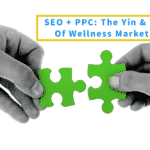Five reasons that health and wellness businesses might consider an outside agency. And in Part 2, five indicators that finding the right marketing agency probably shouldn’t be your top priority.
1. You’re ready to invest time.
If we had a nickel for every time a prospective client came to us with a massive goals that they wanted to achieve in a matter of weeks, wanted to double, triple or quadruple their customer base practically overnight…we’d be sitting on a tropical beach sipping umbrella drinks.
We’ve pulled off some amazing projects in timelines that most agencies wouldn’t even think about attempting.
But there’s always a limit to what can be achieved on a short timeline. You can’t go from 0 to 60 overnight, even if you’re able and willing to throw a large chunk of money at your objective.
It simply takes time.
Time to identify your ideal customer profiles, craft messages that resonate with their goals, priorities, life experiences and reasons for buying, define offers that will actually appeal to them, nurture and qualify leads, and develop the top, middle and bottom of your sales funnel.
Time to develop an onboarding process so that their initial experience after they buy underscores what a great decision they made.
Time to create, test and launch your programs and services — including participant materials like videos or worksheets — and tweak and tune them based on experience and client feedback. And assess their profitability, sales cycle length. Oh, and develop a pricing strategy and suitable Ts&Cs.
Time to analyze your current organic and paid web traffic, ad copy, social engagement, website content, landing page relevance; plus qualitative data like customer retention and surveys. Then grind the data, run the numbers on alternative scenarios and different investment levels, and compare the best, likely and worst-case results to your objectives.
It also takes time to collect the basic assets that feed marketing initiatives — like effective professional photos and sincere and authentic customer stories and testimonials.
Because all of that informs your marketing initiatives.
2. You’re ready to invest money.
Sales and marketing activities need a budget just as much as your programs, services, operations and continuing professional development do.
Some of our clients have tiny marketing budgets, which is perfectly fine. It just means you need to prioritize. For example, in the right situation, it makes perfect sense to focus only on Facebook and skip Instagram and Twitter and LinkedIn entirely. Maybe Google Ads isn’t for you. Or maybe it’s all you should do, and skipping Facebook makes more sense.
What’s best for one wellness business may not fit another. The key is to do the few things you tackle completely, with excellence, and with a relentless focus on results.
If Facebook is all you’re going to do, other than your website, you better take advantage of Every.Single.Feature Facebook offers businesses. Leave no stone unturned, most especially including the reporting on how effective (or not) your marketing is.
If you’re not sure how to do this, or what the reporting tells you, then pay for that kind of help.
If you’ve got deeper corporate pockets, the key is to balance your investments.
Our industry is full of health clubs, fitness centers, yoga studios, medical practices and wellness centers that spend thousands on elaborate aquatic centers, the latest fitness and workout equipment, extensive assessment and treatment programs, diagnostics and facilities — and budget practically nothing to tell people about all this cool new stuff.
If this is you, and you’re suddenly realizing that your sales funnel is frighteningly vacant, this would be an excellent time to reach out for help.
3. You’ve clearly defined your sales and marketing goals.
The payoff from different types of campaigns is dependent on your objectives. Know what you want from your marketing before you start paying someone to go get it. Then, look for an agency who’s actually worked with lots of health and wellness clients and who’ll shoot straight with you.
We talked with a prospect a few months back who wanted to use physician marketing for a lifestyle change program. They were expecting the actual doctor to do a lot of the sales work. And they had unrealistic ideas about what patients were likely to do.
This is an area we know a little — OK, a lot! — about. So we advised some very specific marketing actions, plus an approach that relied on PAs and MAs who provide most of the patient interaction in these practices.
They didn’t like our take, insisted on doing it their way, and we noticed recently that they’ve abandoned their program entirely. I wish I could say I’m surprised.
Is your club the new kid on the block, or new to a particular geography? Your primary goal might be exposure.
Are you working your upstream funnel by creating top-of-mind presence through free demos, webinars, or virtual talk-with-the-trainer sessions? Maybe you’re using assessment tools to help people move from contemplation to preparation or action.
If so, views or downloads or attendance may be more important.
And when you’re trying to close the final gap between very strong interest and a financial commitment, conversions and live interactions — chats, phone calls, etc. — probably deserve center stage.
4. You’re not afraid to prioritize.
The job of sales and marketing is threefold: to build brand awareness, fill the sales funnel, and close new clients, patients or members. All at once.
A well-balanced sales and marketing plan has short-term objectives in each of those areas.
For instance, making your summer revenue targets may mean spring advertising campaigns for your summer camp for kids and increasing senior enrollment in a new yoga program offered in conjunction with a local hospital. At the same time, you may be trying to expand awareness among a market segment that’s new to your business, and increasing retention among the people enrolled in your weight loss program.
Can you do it all at once? If you have the basic assets we talked about earlier, staff that can keep your day-to-day operations on track, and the budget to get outside help, it’s quite possible.
And if your budget won’t allow you to execute on all of those goals immediately, can you prioritize the goals where outside help would be most valuable?
For example, clients often rope us in on new facility or program launches, where they need to build a sales funnel from scratch. They may go with internal resources to market their already popular and well-known annual summer camp and focus short-term on data gathering to help them pinpoint the retention issue, while deferring any deeper retention measures until the program launch is underway.
Many clients come to us with a list of goals. We always ask them: What’s the one thing that would unstick progress in multiple areas? We always look for that ripple effect, because that’s the most strategic and important thing on your list. That’s where you should invest.
Think at a strategic level and the tactical goals will become obvious.
5. You know who your ideal clients are.
One of the earliest discussions we have with potential clients is who they’re trying to sell to. The next step is figuring out if that’s who they’re actually attracting.
Not knowing your ideal client is a pretty serious deficiency. You’ll waste considerable time and money chasing “leads” that will never produce.
The question is whether those are the prospective customers you actually want and need.
When you set up shop on the corner of 5th and McAllister, you presumably had a pretty good idea of who lives nearby or is willing to go out of their way to take advantage of the unique benefits of your team, programs, or facilities.
If you’re not advertising to that audience with a resonant message, you’re doing what sales professionals call “pushing string.”
Without demand, you’ve got either the wrong business (you can’t change a leopard’s spots), the wrong geography (it’s expensive to relocate) or the wrong message.
The easiest fixes are to increase awareness among the kinds of prospective clients you want, or change your messages to fit the customers you’re likeliest to get. Actually changing your business — your programs and services — is far and away the most difficult, and it’s also the least likely to succeed.
Well targeted ads, posts, and landing page content that drive clickthrough and engagement and result in visitors spending significant time on your landing pages will be more highly rated, more frequently presented, and will usually result in lower cost and a higher awareness, click-through, and conversion rate.



